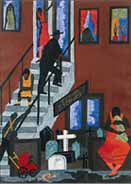|
|
|
Introduction Task Process Resources Evaluation Reflection
This painting shows a Harlem scene of men,
women, and children relaxing on and around a stoop on a hot day in the city.
Jacob Lawrence used symbols to represent the cycle of birth, life, and death.
Limited access to health care and hospitals was a major problem for blacks
in northern cities.
SYMBOL
A symbol is something--usually a sign or an object--that represents or stands
for something else. For example, flags can be symbols for countries and
hearts are often symbols for love.
Back to the Beginning
In this webquest you will:
- Discover how Jacob Lawrence represented family and community in his
paintings.
- Look at family and community photographs on the web.
- Create an album of your family/community.
- Write an essay about who you included and why.
- Present and discuss your album with the class.
Back to the Beginning
|
|
 |
Tombstones,
1942
Gouache on paper
28 3/4 x 22 1/2 in.
(73 X 57.2 cm)
Whitney Museum of American Art, New York; purchase 43.14
© Gwendolyn Knight Lawrence; courtesy of the Jacob and Gwendolyn
Lawrence Foundation |
|
| |
|
- Look at
 Jacob Lawrence's painting, Tombstones. Move your mouse over
the painting and find questions to discuss with your classmates.
Jacob Lawrence's painting, Tombstones. Move your mouse over
the painting and find questions to discuss with your classmates.
- With your teacher, go to
 http://www.jacoblawrence.org/art04.html.
Choose painting as the medium. Type "family" in the "title"
box and click on SUBMIT. Look at other paintings where Jacob Lawrence
has shown families.
http://www.jacoblawrence.org/art04.html.
Choose painting as the medium. Type "family" in the "title"
box and click on SUBMIT. Look at other paintings where Jacob Lawrence
has shown families.
Where are these families?
Notice what people are doing in these paintings.
What objects do you see?
How has Jacob Lawrence communicated ideas about families?
How does the artist show people’s relationship to each other?
As a class discuss the following questions:
What is a family?
How many different examples of family can you think of?
Who do you consider your family?
Your mother? Father? Brothers? Sisters? Relatives? Guardians? Friends?
People in your community?
How do you think of your community?
Your street? Your block? Neighborhood? Neighbors? School? Friends? A club
or group that you belong to?
- Use drawing, painting, photography, or video to make an album of people
in your family and/or community. Include pictures of yourself. Include
as many people as possible whom you consider part of your family and/or
community.
Represent different generations of people in your family or community:
babies, children, teens, adults, and seniors.
You could use existing photos of your family and yourself, or take new
ones.
To compose your images, think about the examples that you saw on the
web.
- Carry a notebook with you. As you make your images, ask people if
they have a comment about family or community, (for example, who they
are, what they do.) Write these comments down to include in your album.
- If you are using a computer, make your album
in
 PowerPoint, Microsoft Word, HyperStudio, KidPix, or other software
that lets you use pictures and words. If you can, add sound. Use your
own voice to communicate information about your family and/or community.
PowerPoint, Microsoft Word, HyperStudio, KidPix, or other software
that lets you use pictures and words. If you can, add sound. Use your
own voice to communicate information about your family and/or community.
- Show how you relate to your family and/or community by the way you
arrange the images and words in your album.
- Write titles for your images. Include people’s comments as captions
for your images.
- Write an essay about who you included in your album and why.
- Present and discuss your albums with the class.
Who did you choose to represent as your family/community? Why?
What were the different ways that you chose to represent people in your
family/community?
What settings did you place people in?
How did you represent different generations?
Back to the Beginning
FAMILY AND COMMUNITY PHOTOS
Click on search. Click on photos and prints. Type the word "families"
in the search box and click on search.
 http://memory.loc.gov/ http://memory.loc.gov/
Photographer Charles "Teenie" Harris.
 http://www.tfaoi.com/aa/2aa/2aa503.htm http://www.tfaoi.com/aa/2aa/2aa503.htm
Personal documentary photographer, Mary Teresa Giancoli.
 http://www.biddingtons.com/content/creativegiancoli.html http://www.biddingtons.com/content/creativegiancoli.html
NYU Family Album Project.
 http://users.rcn.com/tothtron/ http://users.rcn.com/tothtron/
Family photos.
 http://www.city-gallery.com/album/contents.wphp http://www.city-gallery.com/album/contents.wphp
More family photos.
 http://freepages.genealogy.rootsweb.com/ http://freepages.genealogy.rootsweb.com/
~kenmac/famphotos_trotter/album_trotter2.htm
 http://freepages.genealogy.rootsweb.com/ http://freepages.genealogy.rootsweb.com/
~vladimirets/photo_indiv2.htm
 http://www.kariya-porritt.com/SiteStructure/FamilyPhotoAlbums/ http://www.kariya-porritt.com/SiteStructure/FamilyPhotoAlbums/
FamilyPhotoAlbums.html
Back to the Beginning
You will be evaluated on the family album and essay that you create. Your
teacher may also choose to create rubrics for evaluation.
- Refer back to the questions in the
 Process
section. Does your album convey what family means to you and how you
define family, neighborhood and community? Process
section. Does your album convey what family means to you and how you
define family, neighborhood and community?
- Is your essay that accompanies your album well written and does it
show evidence of creativity and originality? Does the text that goes
with the images make sense? Is it also creative?
- Does it include factual information, as well as personal information
such as thoughts, feelings, and emotions about your definition of family?
- Does it include different generations of people, including babies,
children, teens, adults, and seniors?
- If you created a multimedia media presentation that uses sound, how
does the sound affect and enhance the essay? How might different music
(if applicable) convey a different meaning?
 Learning
Standards Addressed Learning
Standards Addressed
Back to the Beginning
Look at your family/community albums together.
What do they have in common?
As a class, how have you portrayed your families/community?
With your teacher, organize an exhibition or presentation of your work for
your peers, family, and community members.
Back to the Beginning |
|









